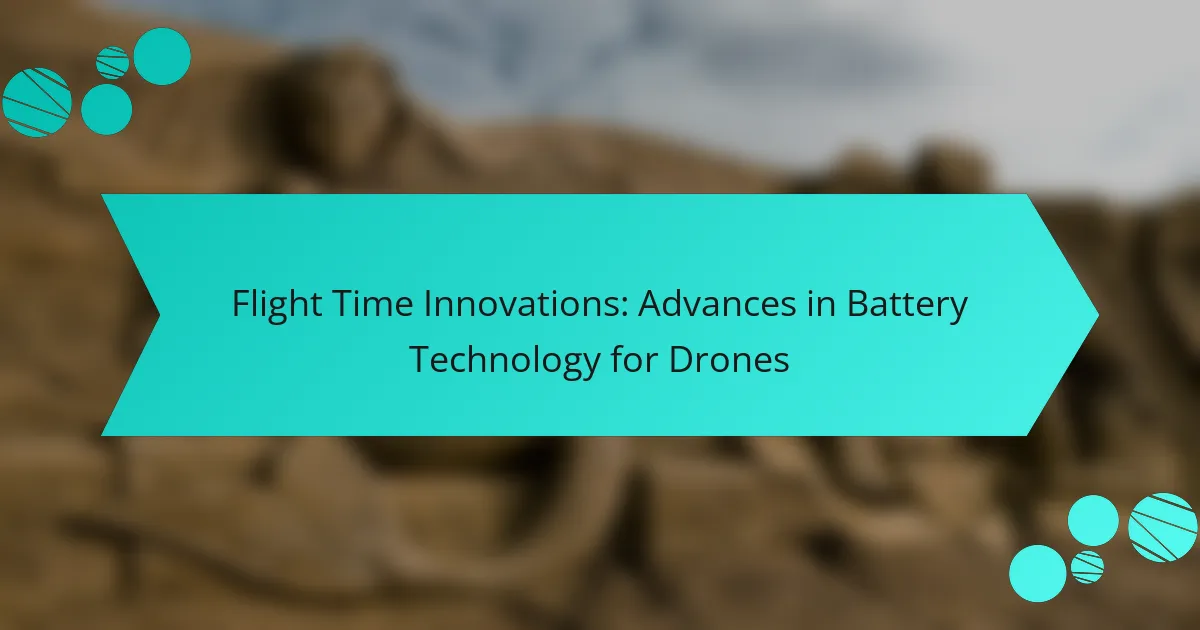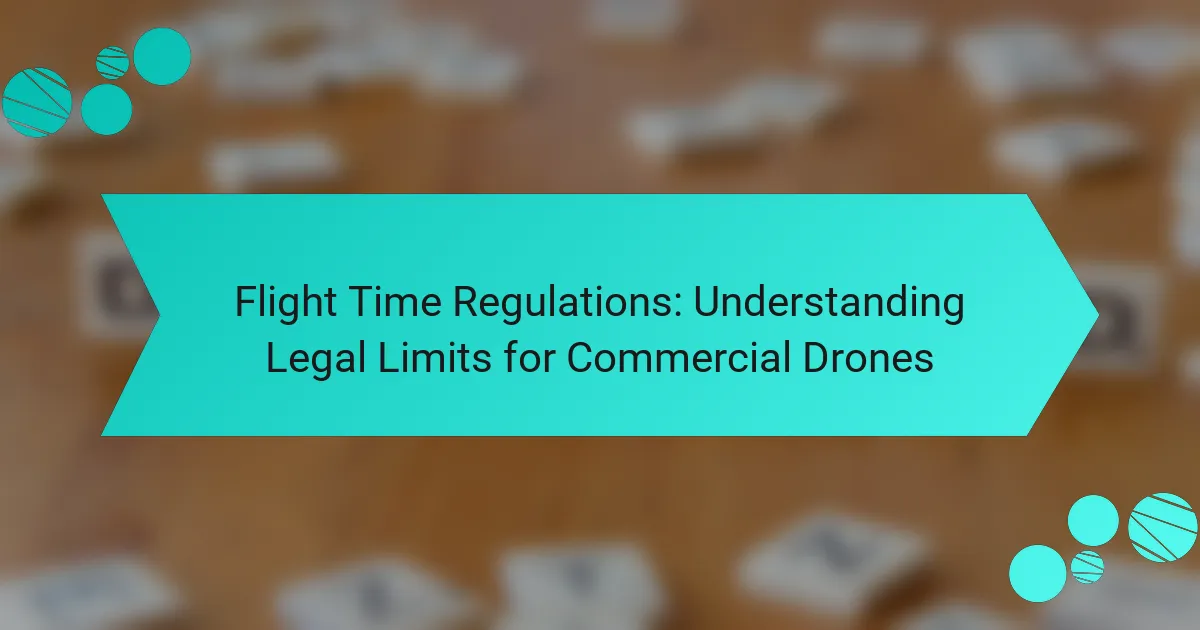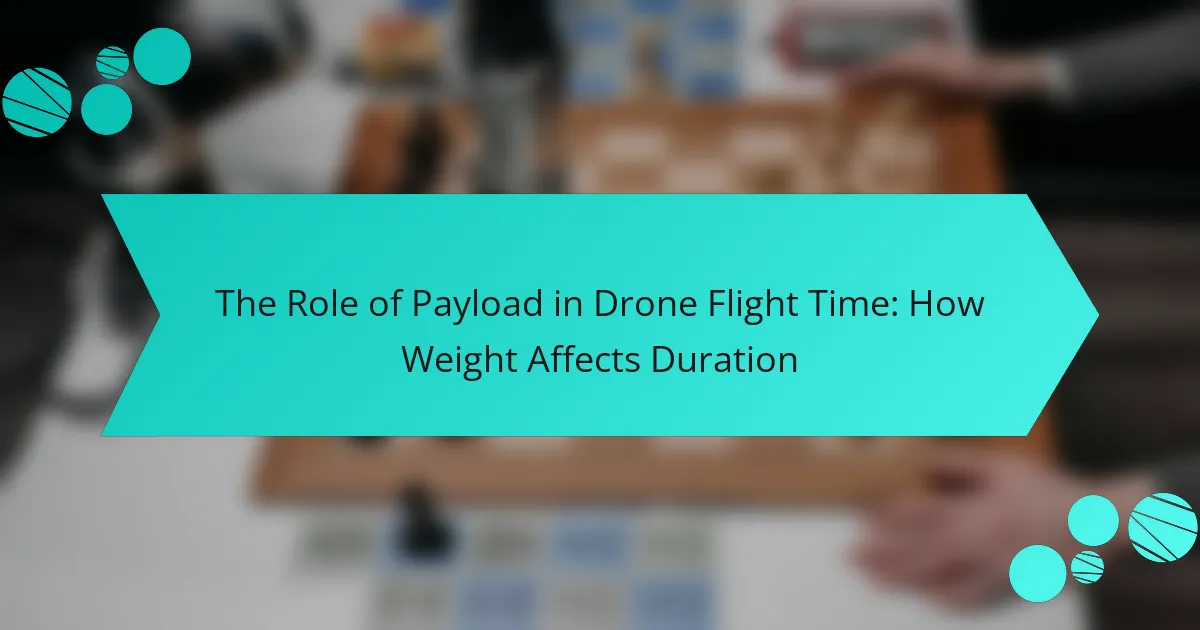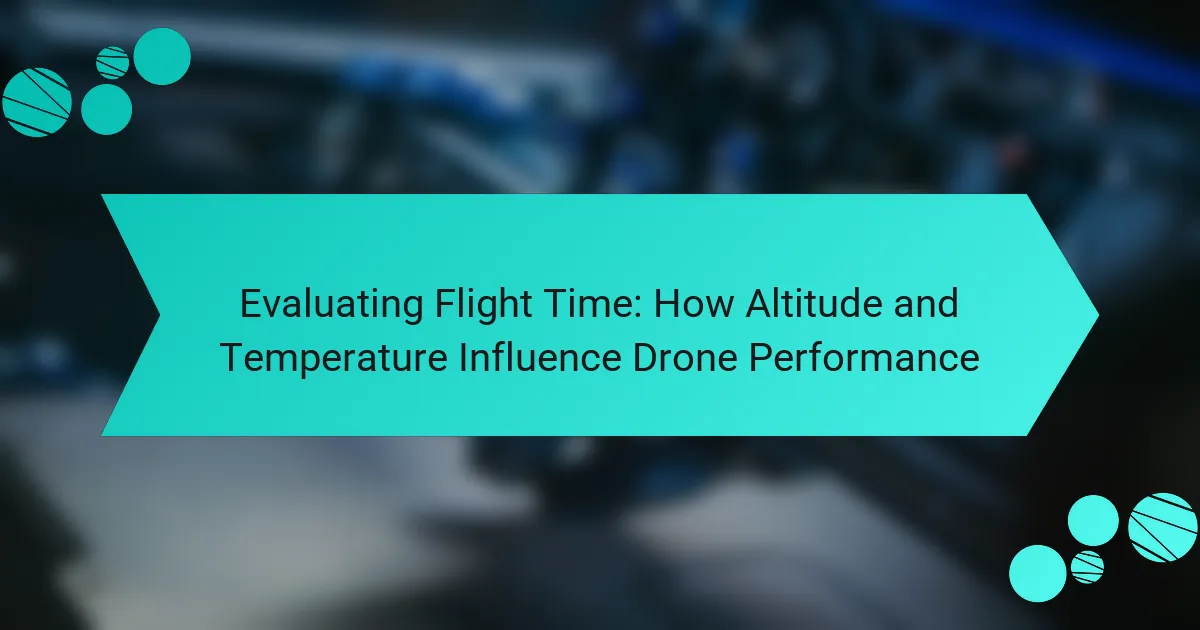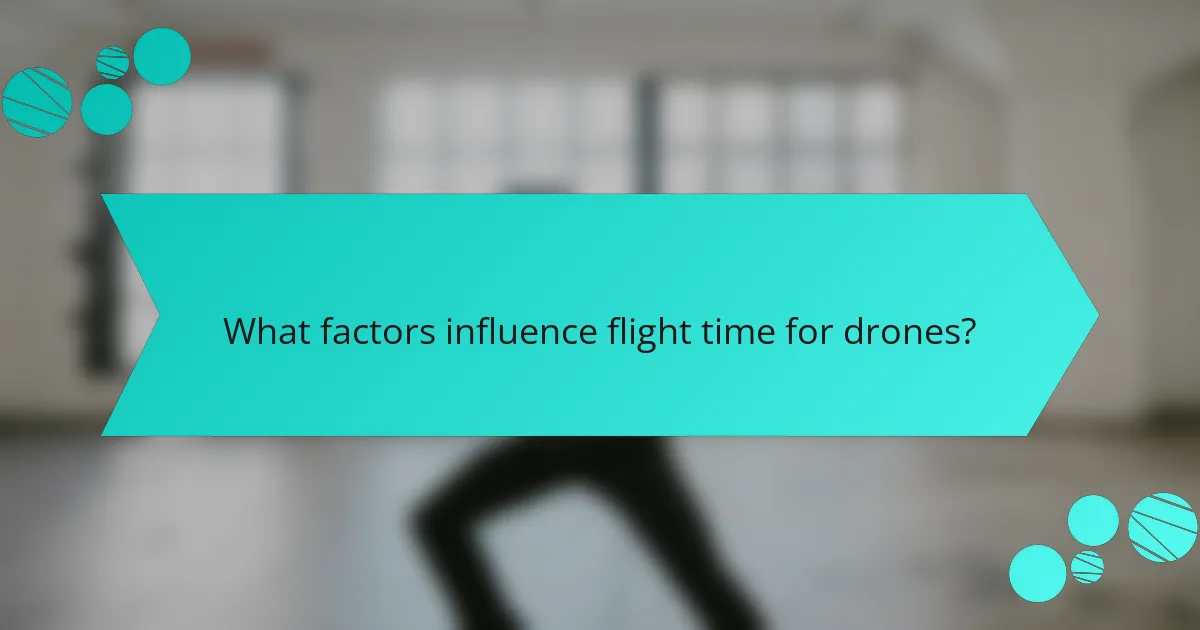
What factors influence flight time for drones?
Flight time for drones is influenced by battery capacity, weight, and environmental conditions. Battery capacity determines how long a drone can operate before needing a recharge. Higher capacity batteries typically provide longer flight times. Weight affects flight time as heavier drones require more energy to stay airborne. Reducing weight can enhance efficiency and extend flight duration. Environmental conditions, such as wind speed and temperature, also play a crucial role. Strong winds can increase energy consumption, reducing flight time. Additionally, extreme temperatures can affect battery performance. Together, these factors significantly impact the overall flight time of a drone.
How does battery capacity affect drone flight time?
Battery capacity directly affects drone flight time. Higher battery capacity allows a drone to fly longer before needing a recharge. For instance, a drone with a 5000 mAh battery can typically achieve longer flight durations compared to one with a 2000 mAh battery. This increase in flight time is due to the greater amount of energy stored in the higher capacity battery. Additionally, flight time is also influenced by factors like weight and power consumption. A heavier drone may require more energy, reducing flight time even with a larger battery. Studies show that optimizing battery capacity can lead to significant improvements in flight efficiency and duration.
What is the relationship between battery capacity and energy consumption?
Battery capacity directly influences energy consumption in drones. Higher battery capacity allows for longer flight times by providing more energy. Energy consumption is determined by factors such as weight, speed, and environmental conditions. For instance, a drone with a 4500 mAh battery can sustain flight longer than one with a 2000 mAh battery under similar conditions. This relationship is crucial for optimizing flight duration. Efficient energy management maximizes the use of available battery capacity. Understanding this relationship helps in designing drones for extended operational periods.
How do different battery types impact flight duration?
Different battery types significantly impact flight duration. Lithium polymer (LiPo) batteries are commonly used in drones for their high energy density. They typically provide longer flight times compared to nickel-cadmium (NiCd) or nickel-metal hydride (NiMH) batteries. LiPo batteries can deliver higher discharge rates, which is crucial for maintaining power during flight.
For example, a 3S LiPo battery with a capacity of 5000 mAh can offer flight durations of 20-30 minutes, depending on the drone’s weight and efficiency. In contrast, a similar capacity NiCd battery may only provide 10-15 minutes of flight time due to its lower energy density.
Additionally, battery weight affects flight duration. Heavier batteries reduce overall flight efficiency, leading to shorter flight times. Therefore, selecting the appropriate battery type is essential for maximizing drone flight duration.
What role does weight play in maximizing flight time?
Weight significantly affects flight time in drones. Increased weight requires more power for lift, reducing efficiency. When a drone carries excess weight, it consumes more battery energy. This leads to shorter operational periods. Studies show that every additional gram can decrease flight time by several seconds. For optimal performance, drones should be lightweight. Balancing payload and battery capacity is crucial for maximizing flight duration.
How does the weight of a drone affect its lift and endurance?
The weight of a drone directly affects its lift and endurance. Increased weight requires more lift to keep the drone airborne. This results in higher power consumption from the drone’s motors. Consequently, greater power usage reduces flight endurance. For example, a drone weighing 1 kg may require 50 watts of power to maintain flight. If the weight increases to 1.5 kg, the power requirement could rise to 75 watts or more. This increased power demand shortens battery life, leading to reduced flight time. Therefore, managing a drone’s weight is crucial for optimizing lift and maximizing endurance.
What are effective strategies for reducing drone weight?
Effective strategies for reducing drone weight include using lightweight materials, optimizing design, and minimizing unnecessary components. Lightweight materials such as carbon fiber and advanced polymers can significantly decrease overall weight. Optimizing the drone’s design for aerodynamics reduces drag and enhances efficiency. Minimizing unnecessary components, such as excess sensors or redundant systems, contributes to weight reduction. Streamlined battery placement can also help maintain balance while reducing weight. Implementing these strategies can lead to improved flight performance and extended battery life.
How do weather conditions impact drone flight time?
Weather conditions significantly impact drone flight time. Factors such as wind speed, temperature, and precipitation can reduce flight duration. High winds increase energy consumption as drones work harder to maintain stability. Cold temperatures can diminish battery efficiency, leading to shorter flight times. Rain or snow adds weight and resistance, further affecting performance. Studies show that flying in winds over 15 mph can reduce flight time by up to 30%. Understanding these conditions helps in planning effective drone operations.
What specific weather factors should drone operators consider?
Drone operators should consider wind speed, precipitation, temperature, humidity, and visibility. Wind speed affects drone stability and control. High winds can lead to difficulties in maneuvering and increased battery consumption. Precipitation, such as rain or snow, can damage the drone’s electronics and reduce visibility. Temperature impacts battery performance; cold temperatures can decrease battery life. High humidity can affect the drone’s sensors and performance. Lastly, visibility is crucial for safe operation; poor visibility can lead to accidents. Each of these factors plays a significant role in ensuring safe and efficient drone flights.
How can adverse weather conditions be mitigated for longer flight times?
Adverse weather conditions can be mitigated for longer flight times by utilizing advanced weather forecasting technologies. These technologies allow pilots to anticipate and avoid severe weather patterns. Implementing real-time data analysis helps in making informed decisions during flight. Additionally, optimizing flight paths can reduce exposure to turbulence and strong winds. Using drones equipped with weather-resistant materials enhances their performance in adverse conditions. Lastly, maintaining battery health through regular checks ensures optimal power usage during challenging weather. These strategies collectively extend flight durations despite adverse weather.
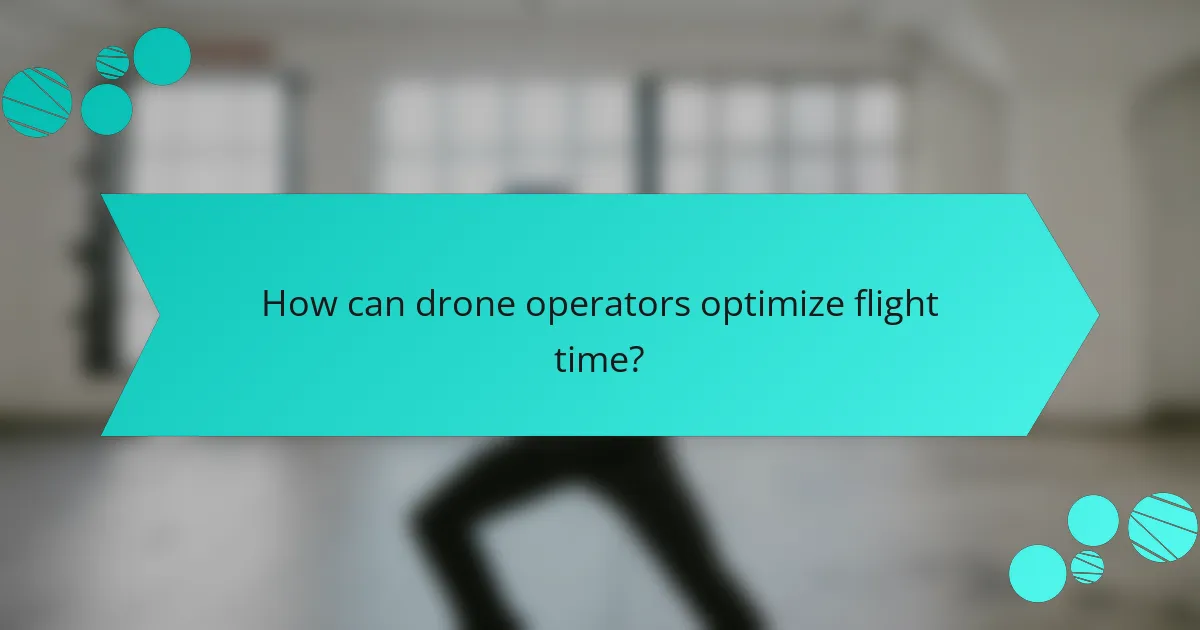
How can drone operators optimize flight time?
Drone operators can optimize flight time by managing battery capacity, weight, and environmental conditions. Ensuring batteries are fully charged before flight is crucial. Using high-capacity batteries can significantly extend flight duration. Reducing the drone’s weight by minimizing unnecessary equipment also enhances efficiency. Operators should monitor weather conditions, as wind and rain can impact battery performance. Flying during optimal weather conditions can maximize flight time. Regular maintenance of the drone ensures that all components function efficiently, which can also help in prolonging flight duration.
What techniques can enhance battery efficiency during flight?
Optimizing battery efficiency during flight involves several techniques. Implementing energy management systems can enhance efficiency significantly. These systems monitor and adjust power consumption in real-time. Utilizing lightweight materials reduces overall weight, improving flight time. Efficient flight paths, such as direct routes, minimize energy expenditure. Regenerative braking can recover energy during descent. Proper battery maintenance ensures optimal performance and lifespan. Temperature management prevents overheating, which can degrade battery efficiency. Lastly, utilizing advanced battery technologies, like lithium-sulfur, can increase energy density.
How do flight patterns influence battery usage?
Flight patterns significantly influence battery usage in drones. Different flight patterns require varying levels of energy consumption. For instance, hovering consumes more battery power than forward flight. Rapid changes in altitude or direction can also increase energy expenditure. Factors like wind resistance and payload weight further impact battery drain during flight. Studies show that drones flying in stable patterns can optimize battery life. Efficient flight paths reduce the overall energy required for a mission. Understanding these dynamics is essential for maximizing flight time and efficiency.
What pre-flight checks can help maximize battery life?
Pre-flight checks that can help maximize battery life include ensuring the battery is fully charged. A fully charged battery can provide optimal performance during flight. Additionally, checking for any physical damage to the battery is essential. Damaged batteries are less efficient and can drain faster.
Another important check is verifying the weight of the drone. Excess weight can lead to increased power consumption. Keeping the drone as light as possible helps extend flight time.
Lastly, monitoring environmental conditions is crucial. Cold temperatures can reduce battery efficiency. Ensuring the drone is operated within the recommended temperature range can help maintain battery life.
What are some best practices for managing drone weight?
To manage drone weight effectively, prioritize lightweight materials for construction. Using carbon fiber or plastic reduces overall weight without compromising strength. Optimize payload by only carrying essential equipment. Excessive gear increases weight and reduces flight time. Regularly check battery weight, as heavier batteries can limit efficiency. Utilize battery management systems to monitor weight distribution. Ensure even weight distribution to maintain stability during flight. Regularly maintain and inspect the drone to avoid unnecessary weight from accumulated dirt or damage. Following these practices can enhance flight performance and extend operational time.
How can payload management contribute to longer flights?
Payload management can significantly contribute to longer flights by optimizing weight distribution and maximizing battery efficiency. Effective payload management ensures that drones carry only necessary equipment, reducing excess weight. Lighter drones require less power to maintain flight, allowing for extended flight durations. Additionally, strategically distributing payload can enhance aerodynamics, further improving flight efficiency. Research indicates that reducing weight by just 10% can increase flight time by approximately 15%. Thus, effective payload management is essential for maximizing flight time in drones.
What materials are recommended for lightweight drone construction?
Carbon fiber is recommended for lightweight drone construction. It offers a high strength-to-weight ratio. This material is durable yet lightweight, making it ideal for drone frames. Another suitable material is foam, which is extremely lightweight and can absorb impacts. Additionally, plastics like polycarbonate are used for their lightweight and strong properties. Aluminum is also a common choice for its balance of weight and durability. These materials help in reducing overall drone weight, enhancing flight time and maneuverability.
How can weather forecasting tools assist in planning drone flights?
Weather forecasting tools assist in planning drone flights by providing critical information about atmospheric conditions. These tools offer data on wind speed, temperature, and precipitation. Accurate wind forecasts help pilots avoid strong gusts that can affect stability. Temperature data is essential for understanding battery performance, as cold conditions can reduce flight time. Precipitation forecasts inform pilots of potential hazards, such as rain or snow, which can impact visibility and drone functionality. Additionally, forecasting tools can predict thunderstorms, allowing pilots to avoid dangerous weather patterns. By integrating this information, drone operators can optimize flight paths and schedules to ensure safety and efficiency.
What are the best resources for real-time weather updates?
The best resources for real-time weather updates include weather websites, mobile apps, and local news stations. Websites like Weather.com and AccuWeather provide detailed forecasts and live updates. Mobile apps such as The Weather Channel and NOAA Weather Radar offer notifications and alerts. Local news stations often have dedicated weather segments with up-to-date information. These resources utilize radar data and meteorological expertise to ensure accuracy. They also provide information on severe weather alerts critical for drone operations.
How can seasonal weather patterns affect flight planning?
Seasonal weather patterns significantly impact flight planning for drones. Changes in temperature, humidity, and wind patterns can alter battery performance and flight stability. For instance, colder temperatures can reduce battery capacity, affecting flight duration. High humidity can lead to increased drag, reducing efficiency. Seasonal wind patterns may also create turbulence, requiring adjustments in flight routes and altitudes. Furthermore, storms and precipitation typical in certain seasons can lead to flight delays or cancellations. Historical data shows that winter months often see increased flight disruptions due to snow and ice. Overall, understanding seasonal weather patterns is crucial for effective flight planning.
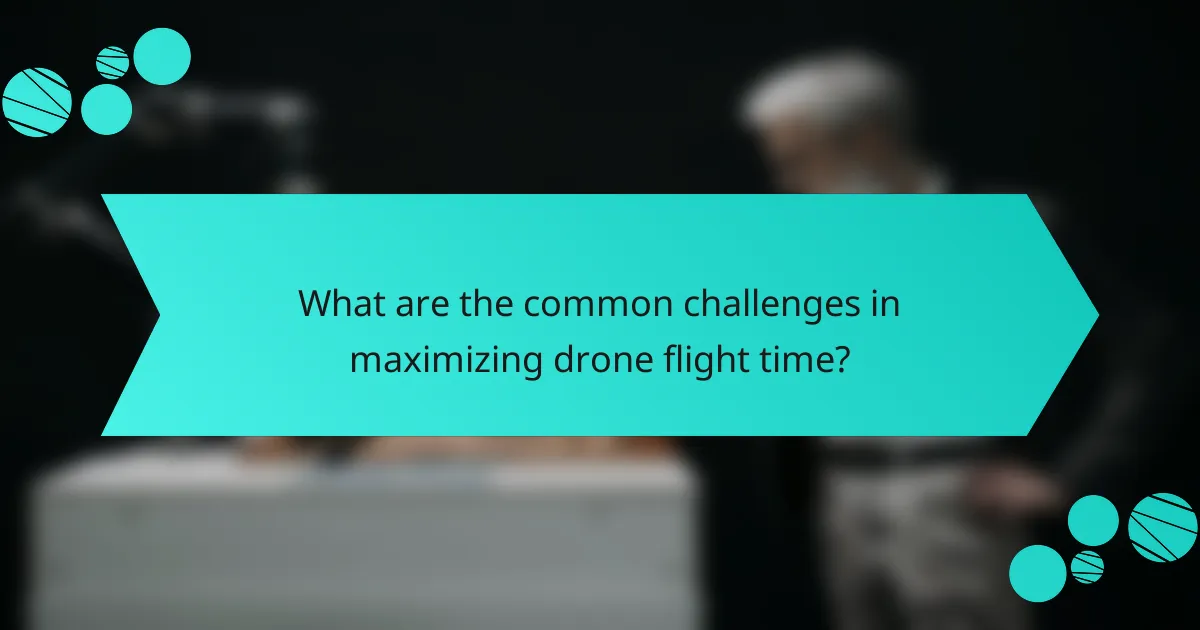
What are the common challenges in maximizing drone flight time?
Common challenges in maximizing drone flight time include battery capacity limitations, weight constraints, and adverse weather conditions. Battery capacity impacts how long a drone can stay airborne. Most commercial drones have batteries that provide limited flight durations, typically ranging from 20 to 40 minutes. Weight affects flight time as additional payloads reduce efficiency. Every gram added can significantly decrease flight time due to increased energy consumption. Weather conditions such as wind and rain can also hinder flight performance. Strong winds require more power for stabilization, leading to faster battery depletion. Collectively, these factors create obstacles that limit the operational time of drones in various scenarios.
How can battery degradation affect flight duration?
Battery degradation reduces the capacity of a battery to hold charge. This leads to shorter flight durations for drones. As batteries age, their ability to deliver power efficiently diminishes. A degraded battery may only provide 70% of its original capacity. This directly impacts the energy available for flight. Consequently, drones may experience reduced operational time. Studies show that battery health significantly correlates with flight performance. For instance, a lithium-polymer battery loses approximately 20% capacity after 300 charge cycles. Thus, battery degradation is a critical factor affecting flight duration.
What signs indicate a battery is losing capacity?
A battery losing capacity shows several signs. One sign is a noticeable decrease in flight time. If a drone’s battery lasts significantly shorter than it used to, this indicates capacity loss. Another sign is the battery heating up during use. Overheating can suggest internal damage or degradation. Additionally, if the battery takes longer to charge, this may indicate reduced efficiency. Swelling or physical deformities on the battery casing also signal potential failure. Lastly, frequent low voltage warnings during operation can confirm that the battery is losing its ability to hold charge effectively.
How often should batteries be replaced to ensure optimal performance?
Batteries should typically be replaced every 1 to 2 years to ensure optimal performance. This timeframe can vary based on usage and battery type. Lithium-ion batteries, commonly used in drones, can lose capacity over time. Regularly replacing them helps maintain flight time and efficiency. Studies indicate that batteries degrade faster with frequent deep discharges. Monitoring battery health can also guide replacement timing. Keeping batteries within recommended temperature ranges prolongs their lifespan.
What challenges do heavy payloads present?
Heavy payloads present several challenges for drone operations. Increased weight affects flight dynamics and reduces maneuverability. This can lead to longer takeoff and landing distances. Heavy payloads also strain battery capacity, resulting in shorter flight times. According to a study by the University of Southern California, every additional gram reduces flight time by approximately 0.1 seconds. Furthermore, heavy payloads can cause wear and tear on motors and components. This may lead to increased maintenance costs and potential mechanical failures. Additionally, navigating adverse weather conditions becomes more difficult with heavy payloads. Stability and control can be compromised in windy conditions. These factors collectively impact the efficiency and safety of drone operations.
How can operators balance payload and flight time effectively?
Operators can balance payload and flight time effectively by optimizing weight distribution and battery capacity. Reducing excess weight improves flight efficiency. Operators should calculate the optimal payload based on the drone’s specifications. For example, a drone with a maximum takeoff weight of 2 kg can typically carry a payload of 500 g without significantly reducing flight time. Additionally, selecting high-capacity batteries can extend flight duration. Using lightweight materials for payload can further enhance performance. Monitoring weather conditions also plays a crucial role. Wind resistance and temperature can affect battery performance and flight time. By combining these strategies, operators can achieve a more effective balance between payload and flight time.
What are the implications of flying in varying weather conditions?
Flying in varying weather conditions can significantly affect drone performance and safety. Adverse weather can lead to reduced visibility and increased turbulence. Rain or snow can impact battery efficiency and increase weight due to moisture accumulation. Wind can cause instability and affect flight control, making it harder to maintain a steady course. Temperature extremes can also impact battery life and overall drone functionality. According to a study by the Federal Aviation Administration, adverse weather conditions are a leading cause of aviation accidents. Therefore, pilots must assess weather forecasts and adjust flight plans accordingly to ensure safety and efficiency.
How can drone pilots prepare for sudden weather changes during flight?
Drone pilots can prepare for sudden weather changes during flight by utilizing real-time weather monitoring tools. These tools provide immediate updates on weather conditions, enabling pilots to make informed decisions. Pilots should also have a contingency plan that includes safe landing zones. Carrying extra batteries can extend flight time in case of unexpected delays. Additionally, understanding the drone’s limitations in adverse weather is crucial. For instance, drones typically struggle in high winds or heavy rain. Pilots should practice emergency landing procedures regularly. Lastly, pilots should stay informed about local weather patterns to anticipate changes.
What practical tips can help maximize flight time for drone operators?
To maximize flight time for drone operators, focus on battery management and weight reduction. Operators should fully charge batteries before each flight. Using high-capacity batteries can significantly extend flight duration. Additionally, reducing the drone’s weight by removing unnecessary accessories improves efficiency. Operators should also fly in optimal weather conditions, avoiding strong winds and rain. Maintaining a steady flight speed conserves battery life. Regularly checking and calibrating the drone’s components ensures optimal performance. Following these tips can lead to longer flight times and enhanced operational efficiency.
The main entity of the article is drone flight time, which is influenced by key factors such as battery capacity, weight, and weather conditions. The article provides a detailed examination of how battery capacity directly affects flight duration, the impact of weight on energy consumption, and the role of environmental factors like wind and temperature. It also discusses strategies for optimizing flight time, including effective battery management, weight reduction techniques, and weather preparedness. By understanding these factors, drone operators can enhance efficiency and extend operational periods.
